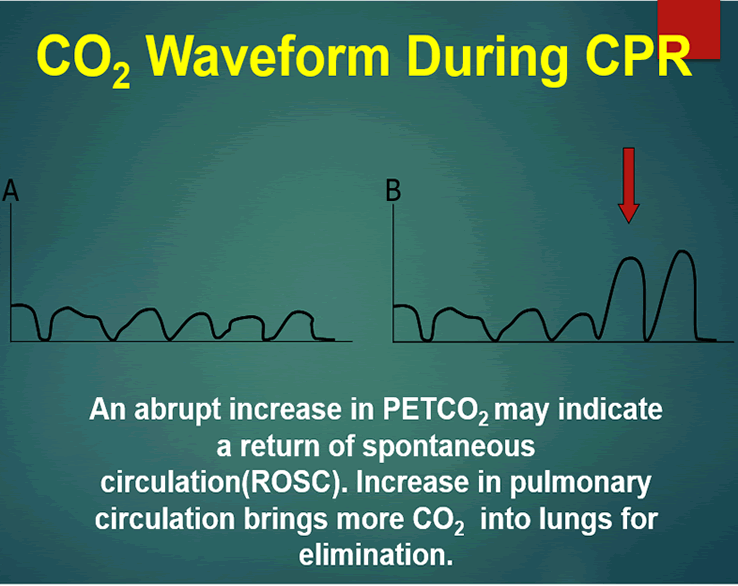low end tidal co2 during cpr
Abrupt increase in ETCO2 suggests ROSC. It is generally lower than arterial partial pressure of CO 2.

Capnograph Note Try To Maintain Etco2 Above 10mmhg During Cpr Icu Nursing Emergency Nursing Respiratory Therapy Student
The end-tidal carbon dioxide CO2 concentration has been found to correlate with cardiac output during and after cardiopulmonary resuscitation CPR in animal models.

. The available studies provided consistent but low-quality evidence that ETCO2measurements 10mmHg obtained at various time points during CPR are substantially related to ROSC. 11172009 4 Measuring End Tidal CO2 Daltons Law. Capnography may be especially useful in cardiac arrest patients as other conventional markers of endotracheal tube placement may be less reliable in these patients.
Gradual fall in ETCO2 suggests compressionist fatigue during CPR - time to change compressionists. Arterial diastolic pressure 25 mm Hg may be useful but not all patient scenarios will be amenable to placement of an arterial line. ETCO2 is a reliable indicator with a high prognostic value in determining the CPR outcome 11 12.
Thus ETco 2 monitoring is a noninvasive way to measure coronary artery blood flow and return of spontaneous circulation during CPR. Association between prehospital cpr quality and end-tidal carbon dioxide levels in out-of-hospital cardiac arrest. Low ETCO2 below 10 mm HG may be caused by either poor compression technique or from low perfusion and metabolism after a long downtime or shock despite good.
Measurement of a low ETCO 2 value 10 mmHg during CPR in an intubated patient suggests that the quality of chest compressions needs improvement. Ensure proper rate approximately. End-tidal carbon dioxide EtCO2 monitoring is recommended for intubated patients at risk of CPA I-A25 EtCO2 correlates well with cardiac output and rapidly drops to zero at CPA onset59.
Evidence suggests a persistently low. Total pressure of a gas is the sum of the partial pressures of the gas Expired CO2 measured PetCO2 mmHg in waveform Percentage. However EtCO2 provides the same information an.
The amount of CO2 at the end of exhalation or end-tidal CO2 ETCO2 is normally 35-45 mm HG. During CPR ETCO2 levels were initially high decreased to low levels and increased again at. Low end tidal co2 during cpr.
Weil MH Bisera J Trevino. Uses during cardiac arrest. End-tidal CO2 EtCO2 is a noninvasive technique which represents the partial pressure or maximal concentration of CO2 at the end of exhalation.
423 20 mmHg versus 34 255 mmHg. 4 to 5 CO2 PetCO2 vs. Low end tidal co2 during cpr Wednesday April 6 2022 The first sign of the return of spontaneous circulation ROSC during CPR is increase in ETCO2.
This will cause a decrease in the ETCO2 end-tidal CO2 and this will be observable on the waveform as well as with the numerical measurement. Normal value is 35-45 mmHg. Systematic review and meta-analysis of end-tidal carbon dioxide values associated with return of spontaneous circulation during cardiopulmonary resuscitation.
In mmHg the PetCO2 values for those with and without ROSC after five minutes of CPR was. Studies have shown that in patients who had ETCO2 of 10 mmHg or less. EtCO2 is essentially to ensuring quality CPR.
Murphy RA Bobrow BJ Spaite DW et al. We typically assess quality of CPR by palpable pulses but this can be challenging and even unreliable. A rapid rise in EtCO 2 during.
Goal is 10 mmHg during CPR. The height of the capnography waveform accompanies this number on the. Monitoring end-tidal carbon dioxide during weaning from cardiopulmonary bypass in patients without significant lung disease.
Normal ETCO2 in the adult patient. The maximum value of CO 2 at the end of the breath is designated as end-tidal partial pressure of CO 2 PETCO 2.

End Tidal Co2 Emergency Medicine Icu Nursing Respiratory Care

Quantitative Waveform Capnography Acls Medical Training

Waveform Capnography In The Intubated Patient Emcrit Project
Emdocs Net Emergency Medicine Educationcapnography In The Ed Emdocs Net Emergency Medicine Education

Use End Tidal Capnography For Placing Orogastric Nasogastric Tubes And Cpr Page 2 Of 4 Acep Now Page 2

Capnography Provides Bigger Physiological Picture To Maximize Patient Care Jems Ems Emergency Medical Services Training Paramedic Emt News

Etco2 Valuable Vital Sign To Assess Perfusion The Airway Jedi

End Tidal Co2 Guided Automated Robot Cpr System In The Pig Preliminary Communication Resuscitation

Reversible Causes Of Low Etco2 In Cpr Criticalcarenow

References In Initial End Tidal Co2 Partial Pressure Predicts Outcomes Of In Hospital Cardiac Arrest The American Journal Of Emergency Medicine

Capnography During Cardiopulmonary Resuscitation Current Evidence And Future Directions

3 Waveform Capnography Showing Changes In The End Tidal Carbon Dioxide Download Scientific Diagram

Graphic Recordings Of Aortic Pressure Aop Air Flow And End Tidal Download Scientific Diagram

Use End Tidal Capnography For Placing Orogastric Nasogastric Tubes And Cpr Page 2 Of 4 Acep Now Page 2

The Role Of Etco2 In Termination Of Resuscitation Jems Ems Emergency Medical Services Training Paramedic Emt News

3 Waveform Capnography Showing Changes In The End Tidal Carbon Dioxide Download Scientific Diagram

Cpr Mobile Code Stand With Capnograph Capnography

The Impact Of Ventilation Rate On End Tidal Carbon Dioxide Level During Manual Cardiopulmonary Resuscitation Resuscitation
